
table of contents
- Dragon tree species from A to D.
- Dragon tree species from F to S
- frequently asked Questions
With their shiny, green, striped, dotted or red-edged leaves, dragon trees are among the most popular indoor plants. The 10 copies in this overview are among the most beautiful Dragon tree-Types and are something for every taste and every room size.
In a nutshell
- In nature, dragon trees grow as upright, single-stemmed shrubs
- also low-growing varieties with spreading forms and heavily branched stems
- palm-like growth, uncomplicated care
- Blossoms in dragon trees are rare, especially when housed in a room
- Species of growth form, but above all of the shape and color of the leaves to be determined
Dragon tree species from A to D.
Dracaena aletriformis (large-leaved dragon tree)
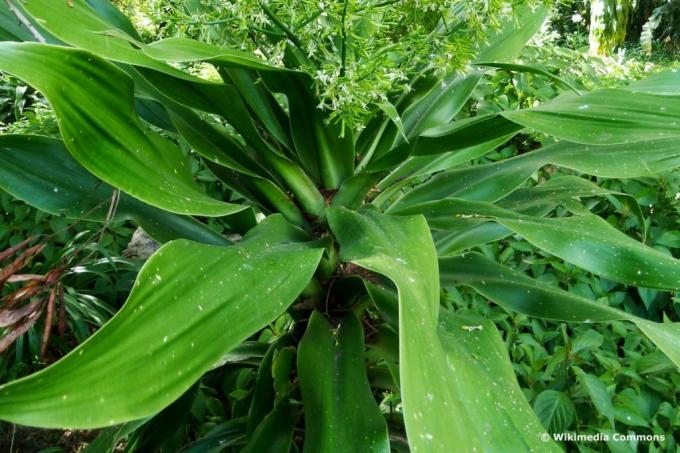
- heavily lignified, sometimes branched trunk
- about 200 cm high
- sword-shaped, glossy green, leathery tough leaves
- white, almost transparent leaf margins
- Cultivar 'Latifolia': leaves taper towards the trunk
- 'Variegata': leaves form numerous thin, white stripes
Dracaena braunii / sanderiana (lucky bamboo)

- like all dragon tree species in this overview not related to bamboo
- grows as a slender, upright shrub
- several side shoots in the lower part of the plant
- rarely higher than 100 cm
- Leaves stiff, about 25 inches long and three inches wide
- dark green with white stripes and edges
Dracaena compacta (pineapple dragon tree)

- Breeding off Dracaena deremensis
- shiny, dense, sword-shaped foliage
- arranged in pretty leaf rosettes
- Rosettes are reminiscent of a pineapple plant
- strong leaves with a particularly noticeable dark green hue
- Leaves are mostly upright
- The stem resembles a walking stick
- Growth height varies between 80 and 90 cm
Dracaena deremensis
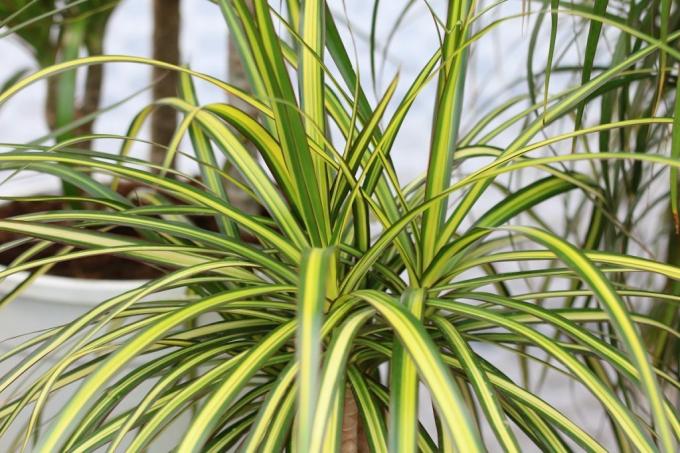
- relatively broad leaves, beautiful rosette of leaves
- Depending on the variety, different proportions of white
- dark green, slightly dull to glossy leaves, approx. 45 cm long
- upright in the first leaf section, sloping slightly towards the tip
- Height from 80 to 120 cm
- high humidity is important
- The 'Bausei' variety has a striking white central stripe
- 'Warneckii': green central stripe bordered by two light stripes
Dracaena draco (Canarian Dragon Tree)

- long, sword-shaped leaves
- narrow, slightly leathery, curved
- blue-gray with a narrow, reddish leaf margin
- reaches heights of up to 160 cm
- a low rosette when young
- Leaves at the tip of a thick, heavily lignified stem when old
- Slightly overhanging over time
Note: In the wild, this type of dragon tree can reach a height of up to 20 meters.
Dragon tree species from F to S
Dracaena fragrans (scented dragon tree)
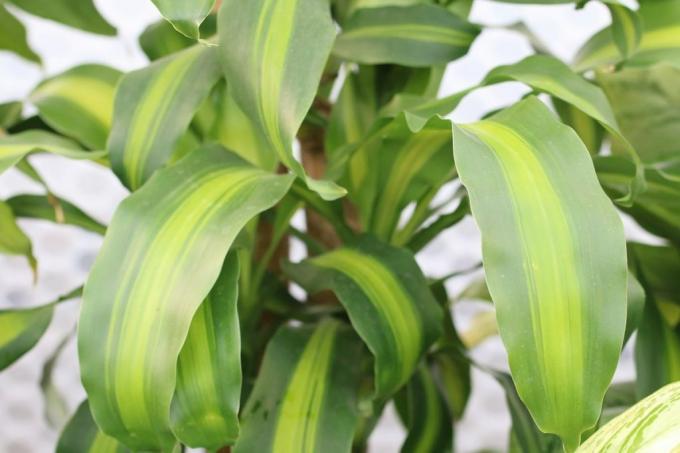
- Leaves shiny, often variegated green, slightly bulbous
- in indoor culture stature heights of approx. 200 cm
- lower leaves are thrown off
- Formation of a squat, bare trunk with colorful tufts of leaves
- strong scented flowers under optimal conditions
- 'Lindenii' variety: creamy white stripes on the leaf margins
- 'Massangeana': broad yellow central strip, partly lined with narrower yellowish lines
- 'Victoria': broad, yellow stripes on the leaf
Dracaena goldieana
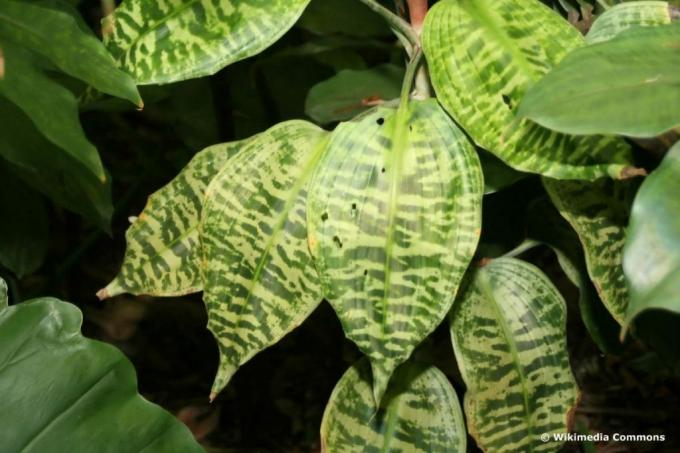
- Subspecies of Dracaena marginata
- belongs to the low growing dragon trees
- slender unbranched trunk
- mostly only 30 cm high
- Leaves very narrow, elongated, oval shaped
- light green with silvery-gray transverse bands
- Middle rib yellowish in color
- with the best care, very small, strongly scented, white flowers
Tip: This dragon tree can also cope with less light, but should not be too dark. It also needs constant temperatures and high humidity.
Dracaena marginata (Edged Dragon Tree)

- one of the particularly easy to cultivate dragon tree species
- robust against changed conditions
- reaches heights of about 200 cm
- easy to identify by their particularly narrow leaves
- dark green, shiny, approx. 40 cm long
- Leaf margins white, reddish in color
- in the course of time the trunk becomes bald with bushy tufts of leaves
- 'Tricolor' variety: green, cream-colored and pink-red striped leaves
Tip: As it grows, the lower leaves of the narrow-leaved dragon tree turn yellow and fall off. The characteristic triangular scars of the leaf roots remain on the trunk.
Dracaena reflexa
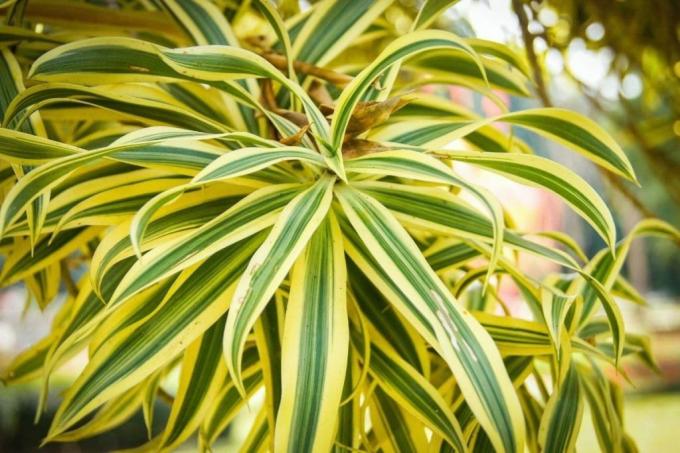
- Super type of Dracaena marginata
- probably the most popular type
- forms an upright, partly strongly branched trunk
- Leaves dark green, about 16 cm long
- white variegated cultivar 'Song of India', particularly popular
- however, it tends to be top heavy
- young leaves are medium green with a lime green margin
- light green with a yellow border when old
- Height of growth 100 to 150 cm and more
Dracaena surculosa (white spotted dragon tree)
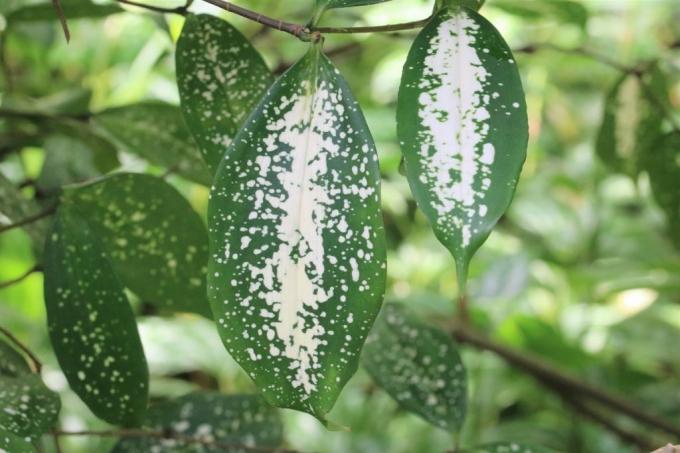
- is one of the heavily branched dragon tree species
- not immediately recognizable as a dragon tree
- thin plant stalks are more reminiscent of small bamboo
- lush, shrub-like growth with richly branched shoots
- in indoor culture between 100 and 200 cm high
- Leaves sit on thin shoots
- dark green, 10 cm long, 5 cm wide
- more or less conspicuously dotted
- easy to determine on the basis of the extraordinary stain
- 'Florida Beauty' variety: patches larger and more dense
- 'Kelleri' variety: thicker
Tip: The room temperature for this dragon tree should be permanently above 15 degrees.
frequently asked Questions
All dragon tree species in the overview are poisonous and that in all parts of the plant. Especially for pets such as dogs, cats and rabbits. Symptoms of poisoning only occur when large amounts of plant material are consumed.
It is no less or more susceptible than other indoor plants. Infestation with scale insects, thrips or spider mites is possible, especially during the warm season and when the heating air is suitably dry.
This can have different causes. The humidity can be too low or the earth too dry. In addition, a sudden change of location is an option as well as repeated touches for example because the plant is in a passageway and you always see it when you walk by grazes again.
The dragon tree species listed in the overview are usually all suitable for hydroponics. Regular repotting is unnecessary, it no longer has to be watered as often and allergy sufferers can breathe a sigh of relief.



